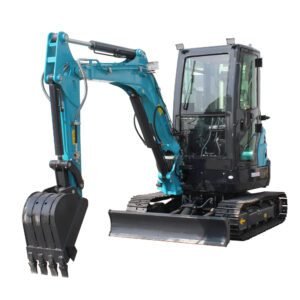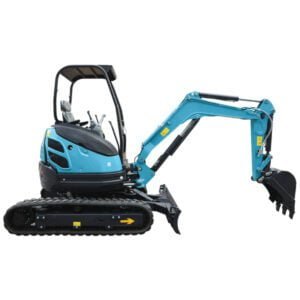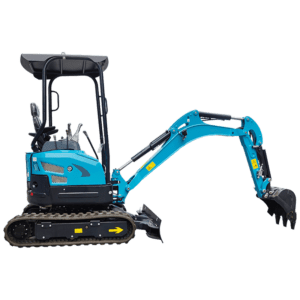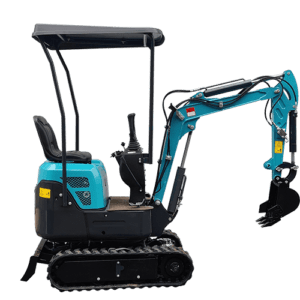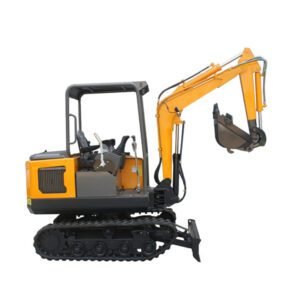Correo electrónico: [email protected] WhatsApp: 8618266768780
Características clave a buscar en la miniexcavadora más pequeña
Introducción
Al considerar comprar la miniexcavadora más pequeña, comprender las características clave es fundamental para garantizar que obtenga la mejor máquina para sus necesidades. Las miniexcavadoras más pequeñas son ideales para proyectos de construcción, paisajismo y trabajos de servicios públicos a pequeña escala debido a su tamaño compacto y versatilidad. En este blog, exploraremos las características esenciales a tener en cuenta al elegir la miniexcavadora más pequeña, asegurándonos de que tome una decisión informada.
Potencia y rendimiento del motor

The engine is the heart of any excavator, and the smallest mini excavator is no exception. Even though they are compact, these machines require a powerful and efficient engine to perform various tasks effectively.
Caballos de fuerza y torque
When evaluating engine power, focus on horsepower and torque. These specifications determine how efficiently the smallest mini excavator can handle heavy loads and tough terrains.
| Especificación | Minimum Requirement | Recommended |
|---|---|---|
| Caballo de fuerza | 10 caballos de fuerza | 15-20 caballos de fuerza |
| Esfuerzo de torsión | 20 lb-ft | 30-40 lb-ft |
Eficiencia de combustible
Fuel efficiency is another critical aspect. The smallest mini excavator should offer good fuel economy to keep operational costs low. Look for machines with eco-friendly engines that comply with emission standards.
Sistema hidráulico
The hydraulic system is responsible for the movement and operation of the excavator’s arm and attachments. In the smallest mini excavator, a robust hydraulic system ensures smooth and precise operations.
Caudal hidráulico
The flow rate of the hydraulic system affects the speed and power of the excavator’s movements. Higher flow rates typically mean better performance.
| Caudal hidráulico | Minimum Requirement | Recommended |
|---|---|---|
| Gallons per Minute | 5 GPM | 10-15 GPM |
Auxiliary Hydraulic Options
Check for auxiliary hydraulic options which allow for the attachment of various tools, enhancing the versatility of the smallest mini excavator. Common attachments include augers, breakers, and grapples.
Maniobrabilidad y tamaño
One of the most significant advantages of the smallest mini excavator is its compact size, making it ideal for tight spaces and small job sites. However, maneuverability and size considerations are crucial.
Peso operativo
The operating weight affects both transportation and operation. Lighter machines are easier to transport and can operate on softer ground without causing damage.
| Peso operativo | Minimum Requirement | Recommended |
|---|---|---|
| Peso | 1,500 libras | 2,000-3,000 lbs |
Dimensiones
Check the dimensions of the smallest mini excavator, including height, width, and length. These factors determine where the machine can operate and store.
Radio de giro
A smaller turning radius enhances maneuverability, allowing the smallest mini excavator to operate efficiently in confined spaces.
Accesorios y versatilidad
The versatility of the smallest mini excavator is enhanced by the variety of attachments it can use. Assessing the availability and compatibility of these attachments is essential.
Archivos adjuntos comunes
| Adjunto | Caso de uso |
|---|---|
| Balde | Digging and material handling |
| Barrena | Perforación de agujeros para postes y cimientos. |
| Martillo hidráulico | Demolition and breaking up hard materials |
| Luchar | Handling bulky materials and debris |
Quick Coupler
A quick coupler system allows for fast and easy attachment changes, increasing the productivity and versatility of the smallest mini excavator.
Comodidad y controles del operador
Operator comfort and ease of control are crucial for the efficient and prolonged use of the smallest mini excavator. A well-designed operator environment not only enhances productivity but also ensures the safety and well-being of the operator during long hours of operation.
Cabin Design
A spacious and ergonomically designed cabin is essential for operator comfort. Look for cabins with ample legroom, adjustable seating, and a layout that minimizes operator fatigue. The seat should provide good lumbar support and be adjustable to accommodate operators of different heights and preferences. Additionally, the control panel should be within easy reach, allowing the operator to work comfortably and efficiently.
Controls and Displays
Modern excavators come equipped with advanced controls and displays that enhance operational efficiency. Intuitive control layouts, such as joystick or lever controls, enable precise movements and reduce the learning curve for new operators. Digital displays provide real-time information on the machine’s status, including fuel levels, engine performance, and hydraulic pressures. These displays can also alert operators to maintenance needs or potential issues, helping to prevent downtime and costly repairs.
Control del clima
Climate control is a significant factor in operator comfort, especially in extreme weather conditions. Look for cabins equipped with heating and air conditioning systems to ensure a comfortable working environment year-round. Proper ventilation is also important to maintain air quality within the cabin, reducing the risk of operator fatigue and discomfort.
Visibility and Safety Features
Good visibility from the operator’s cabin is crucial for safe and efficient operation. Large windows, well-placed mirrors, and optional camera systems can enhance visibility, allowing the operator to see the work area clearly and avoid obstacles. Additionally, features like Rollover Protection Systems (ROPS) and Falling Object Protective Structures (FOPS) provide an extra layer of safety, protecting the operator in hazardous situations.
Noise and Vibration Reduction
Operating an excavator can be noisy and cause vibrations, which can lead to operator fatigue and discomfort over time. Modern mini excavators often include noise and vibration reduction features, such as insulated cabins, dampened engine mounts, and advanced hydraulic systems. These features help create a quieter and smoother operating environment, allowing the operator to work longer without experiencing fatigue or discomfort.
Storage and Convenience Features
Small conveniences can make a big difference in operator comfort. Look for cabins with ample storage space for personal items, cup holders, and power outlets for charging devices. These features may seem minor but can significantly enhance the overall operating experience, making the workday more pleasant and productive.
Mantenimiento y durabilidad
The smallest mini excavator should be easy to maintain and built to withstand rigorous use over time. Ensuring that your excavator is both durable and easy to maintain can significantly reduce downtime, lower operational costs, and extend the machine’s lifespan.
Access to Components
Ease of maintenance starts with how accessible the excavator’s components are. The design of the smallest mini excavator should allow quick and straightforward access to key areas such as the engine, filters, hydraulic lines, and battery. Look for models with easily removable panels or doors that provide ample space for routine inspections and maintenance tasks. Quick access to these components can minimize downtime and ensure that the excavator is always in optimal working condition.
Características de durabilidad
Durability is a critical factor in ensuring that the smallest mini excavator can handle the demands of various job sites. Key durability features to look for include reinforced booms and arms, high-quality steel construction, and protective structures like heavy-duty undercarriages. These elements help the excavator withstand tough working conditions and reduce the risk of wear and tear. Additionally, look for features such as sealed joints and bushings that minimize the ingress of dirt and debris, further enhancing the machine’s longevity.
Maintenance Schedule
A well-defined maintenance schedule is crucial for keeping the smallest mini excavator in peak condition. This schedule should include regular checks and replacements of engine oil, hydraulic fluids, filters, and other consumable parts. Many modern mini excavators come equipped with digital maintenance reminders that alert operators when service is due, helping to prevent neglect and potential damage. Adhering to the manufacturer’s recommended maintenance intervals can prevent unexpected breakdowns and extend the machine’s lifespan.
Quality of Parts
The quality of the parts used in the smallest mini excavator significantly impacts its durability and maintenance needs. High-quality, OEM (Original Equipment Manufacturer) parts ensure that the machine operates efficiently and reliably. Using genuine parts for replacements and repairs helps maintain the integrity of the excavator and prevents compatibility issues that can arise with aftermarket alternatives.
Servicio y soporte
Reliable service and support from the manufacturer or dealer are essential for maintaining the smallest mini excavator. Choose a brand that offers strong customer support, including readily available spare parts, comprehensive warranties, and access to skilled technicians. Good after-sales support can make a significant difference in resolving issues quickly and keeping the excavator operational.
Wear and Tear Monitoring
Monitoring wear and tear is an essential part of maintaining the smallest mini excavator. Advanced models may include features like telematics systems that track usage patterns, wear on components, and overall machine health. These systems provide valuable data that can help operators and maintenance teams anticipate when parts will need replacement and schedule maintenance proactively. By keeping a close eye on wear and tear, you can prevent minor issues from becoming major problems, ensuring the excavator remains reliable and efficient.
Regular Training
Ensuring that operators are properly trained in the use and maintenance of the smallest mini excavator is also vital. Proper training can reduce the risk of operator error, which can lead to damage and increased maintenance needs. Many manufacturers offer training programs that cover both operational best practices and routine maintenance procedures. Investing in operator training can pay off in the long run by extending the life of the excavator and reducing overall maintenance costs.
Caracteristicas de seguridad
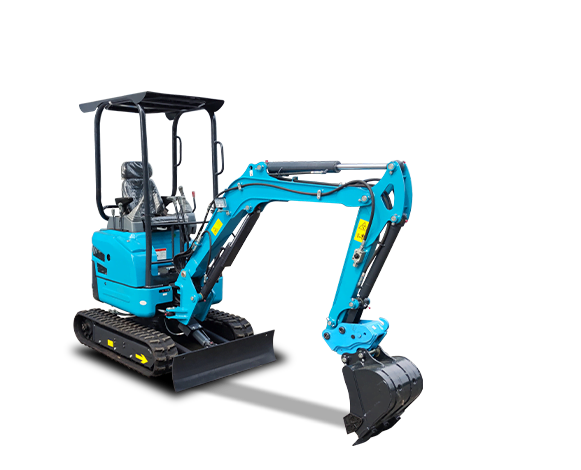
Safety is paramount when operating any construction equipment, and the smallest mini excavator is no exception. Ensuring that the machine is equipped with essential safety features can protect both the operator and those around the worksite. Here are the critical safety features to look for in the smallest mini excavator.
Sistema de protección antivuelco (ROPS)
The Rollover Protection System (ROPS) is a fundamental safety feature that helps protect the operator in the event of a rollover. This structure is designed to absorb and dissipate the energy from a rollover, reducing the risk of injury. When selecting the smallest mini excavator, ensure it is equipped with a certified ROPS structure that meets industry safety standards.
Falling Object Protective Structure (FOPS)
The Falling Object Protective Structure (FOPS) is another critical safety feature that protects the operator from falling debris and objects. This structure is especially important when working in environments where there is a risk of materials falling from above, such as demolition sites or areas with overhead hazards. A robust FOPS ensures the operator is shielded from potential impacts, enhancing overall safety.
Emergency Shutoff
An emergency shutoff switch is an essential feature that allows the operator to quickly stop the machine in case of an emergency. This switch should be easily accessible and clearly marked, enabling immediate response to potential hazards. The ability to quickly power down the machine can prevent accidents and minimize damage.
Visibility Enhancements
Good visibility is crucial for safe operation. The smallest mini excavator should offer excellent visibility from the operator’s cabin, allowing a clear view of the work area and surroundings. Large windows, strategically placed mirrors, and optional camera systems can significantly enhance visibility. Some models also come with rearview cameras and 360-degree view systems, providing comprehensive awareness of the environment and reducing blind spots.
Warning Systems
Modern mini excavators often come equipped with various warning systems that alert the operator to potential issues. These can include audible alarms, visual indicators on the control panel, and even vibration alerts in the operator’s seat. Common warning systems monitor engine temperature, hydraulic pressure, and other critical parameters, alerting the operator to take corrective action before a problem escalates.
Seatbelts and Restraints
Operator seatbelts and restraints are basic but essential safety features. Ensure that the smallest mini excavator is equipped with a reliable seatbelt system to keep the operator securely in place during operation. A properly worn seatbelt can prevent the operator from being thrown out of the seat in case of a sudden stop or accident.
Anti-Slip Surfaces
Safety extends beyond the operator’s cabin. Anti-slip surfaces on the steps and handholds of the mini excavator help prevent slips and falls when entering or exiting the machine. These surfaces are especially important in wet or muddy conditions commonly found on construction sites.
Encendiendo
Adequate lighting is crucial for safe operation, particularly in low-light conditions or during nighttime work. The smallest mini excavator should be equipped with powerful, adjustable work lights that illuminate the work area and surrounding environment. LED lights are a common choice for their brightness and energy efficiency. Additional lighting features, such as beacon lights and indicators, can further enhance safety by increasing the machine’s visibility to others on the job site.
Operator Training and Safety Protocols
While not a built-in feature, proper operator training and adherence to safety protocols are essential for safe operation. Operators should be trained on the specific mini excavator they will be using, understanding all safety features and emergency procedures. Regular safety drills and refresher courses can help maintain a high standard of safety awareness on the job site.
Telematics and Monitoring Systems
Advanced telematics and monitoring systems can enhance safety by providing real-time data on machine performance and operator behavior. These systems can track aspects such as speed, operation hours, and maintenance needs, alerting operators and supervisors to potential safety risks. Some systems also offer geofencing capabilities, which can restrict the machine’s operation to designated safe areas, preventing unauthorized or hazardous use.
Conclusión
Choosing the smallest mini excavator requires careful consideration of various features to ensure it meets your operational needs. From engine power and hydraulic performance to maneuverability and safety features, each aspect plays a vital role in the machine’s efficiency and productivity. By focusing on these key features, you can make an informed decision and select the best smallest mini excavator for your projects.
Preguntas más frecuentes
What is the smallest miniexcavadora available?
The smallest mini excavator available typically weighs around 1,500 pounds and has a width of less than 3 feet, making it ideal for tight spaces and small-scale projects.
How much does the smallest miniexcavadora ¿costo?
The cost of the smallest mini excavator can vary widely based on features, brand, and attachments. On average, prices range from $20,000 to $40,000.
What are the benefits of using the smallest mini excavator?
The smallest mini excavator offers numerous benefits, including easy maneuverability in tight spaces, lower operational costs, and versatility with various attachments.
Can the smallest mini excavator be used for landscaping?
Yes, the smallest mini excavator is excellent for landscaping tasks such as digging, grading, and planting due to its compact size and versatility.
How do I maintain the smallest mini excavator?
Regular maintenance of the smallest mini excavator includes checking and changing the engine oil, inspecting hydraulic lines, cleaning filters, and following the manufacturer’s recommended maintenance schedule.
Sobre nosotros
Shandong Qilu Industrial Co., Ltd. es un fabricante y exportador profesional que integra el desarrollo y la producción de excavadoras, cargadoras y tractores. Brindamos el mejor servicio, absolutamente.
Mensajes recientes
demostración de vídeo
-1.png)
¡Póngase en contacto con nosotros hoy!
¿Alguna pregunta, cotización o consulta? Haga clic en el botón para enviar el mensaje.
Qilu Industrial siempre estará aquí para ayudar.

